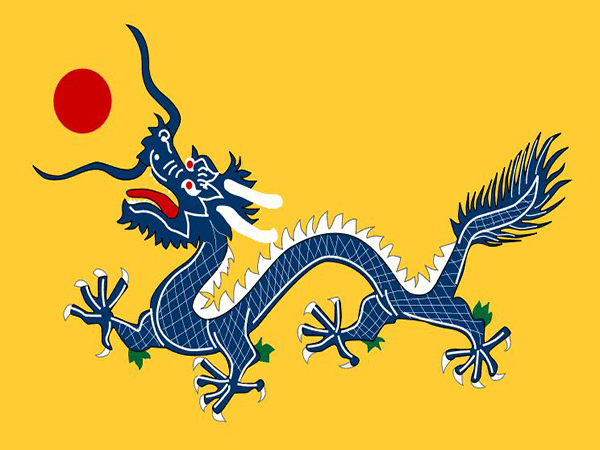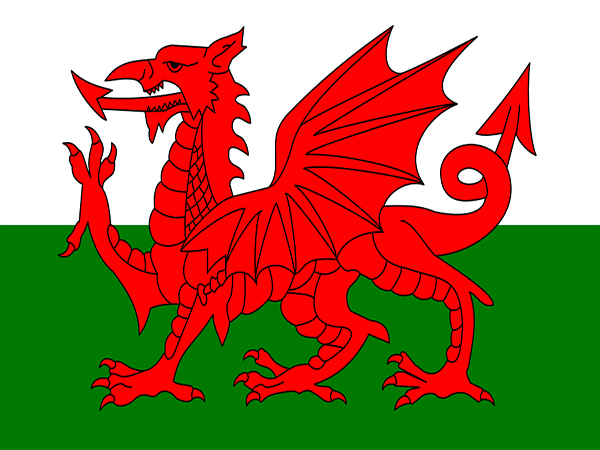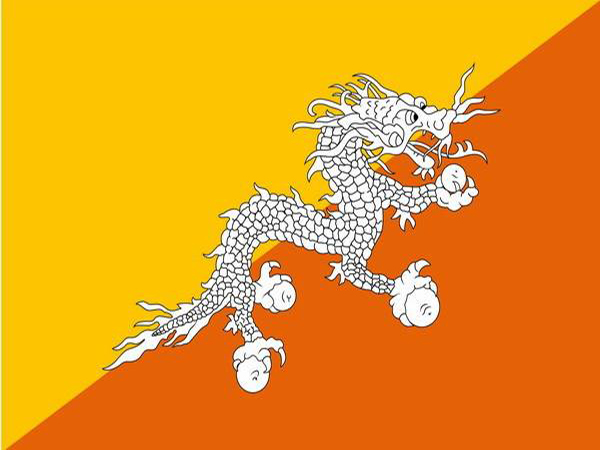Dragon, a powerful creature, has special meanings in western and eastern countries, and it has been somewhat considered as a belief. There is no wonder that it becomes a cultural sign and emblem, and is adopted as an element in flag. In the world, there are some typical flags with dragon element, like the flag of the Qing Dynasty, the flag of Wales and the Flag of Bhutan.
Flag of the Qing Dynasty
Flag of the Qing Dynasty is the first national flag of China, with a blue dragon and a red flaming pearl in the yellow field, which is usually named as the “yellow dragon flag” in China. Before the forming of this flag, there are many flags in the imperial dynasties, but they are never granted as national flag. In ancient China, there are flags of army, but there isn’t a national flag. At the beginning, the flag is designed in triangle, and isn’t officially made as national flag, and it is used in official ships and navy warships to differentiate them from ships of foreign countries. In 1888, it was made in rectangle, used as national flag, and expired in 1912, since the imperial ruling of the Qing Dynasty was overthrew.
The design notion of this flag comes from flags of the Eight Banners, which is an army system and has eight troops of royal army loyal to the Emperor. And each banner has a flag of a dragon and a flaming pearl in the center. The Flag consists of a yellow field, a blue dragon and a red flaming pearl. In the Wu Xing(the Five Elements), the central has the attribute of earth element, and earth is yellow, thus yellow represents the central government and the country. In Chinese culture, yellow is the noblest color among the five basic colors, yellow, blue, white, red and black. Yellow is also officially used by the royal, which is selected as the color of Dragon Robe. A five-claw dragon represents the Emperor and the country, which is used by the Emperor only, while dragon with four or three claws can’t represents the Emperor and the country in the Qing Dynasty. Blue dragon or azure dragon is one of the most popular dragon in China, and it is the dragon in the east which is considered as a noble direction in China.
Two events prompted the government to design the national flag. In 1856, a ship named Arrow was detained by the navy in Guangdong province for its participation in pirate activity. The officer of British consulate in Guangzhou asked Guangzhou navy to release the ship for the reason that the ship was registered in Hongkong, and hanged the national flag of British, and required compensation and apology from Guangzhou navy because the navy ripped down and insulted the flag. In 1862, navy soldiers of the Qing Dynasty and British had a fight in Yangtze River. In the process of dealing with this fight, the British declined to be responsible for the fight, because the Chinese navy ships didn’t have national flag, and the British didn’t know they are the ships of government. The two events have caused sovereign problems for the government, which become the biggest reason to make a national flag. Then in the same year, a triangular yellow dragon flag was made and used in Chinese official ships. In 1888, government officers attended official diplomatic events and found that they didn’t have a national flag to represent their country. With the agreement from the Empress Dowager Cixi, the triangular yellow dragon flag was made into rectangular, and the rectangular flag was officially declared as nation flag.
Flag of Wales
Flag of Wales is the national emblem of Wales, which is also named the Red Dragon or Y Ddraig Goch in Welsh. The Flag has a plain field of green and white color, with a red dragon in the center. The green color and the white color evenly divide the field into two parts, with the green in the lower and white in the upper. The passant red dragon is similar to the appearance of western dragon, having four legs, bat-like wings and a prehensile tail. The scaly dragon has a long nose, and a protrusive tongue, which looks fierce.
The red dragon has been used in Wales for centuries, which symbolizes Wales. At the mention of Wales, people would associates the red dragon with Wales, but people never know why the red dragon is used in Wales. Though its origin has been lost, there is a theory telling that the Romans brought the dragon to Wales during their occupation of Britain. The use of the red dragon to represent Wales is first told in a war between two dragons, a white dragon and a red dragon. In the prophecy made by Merlin, the white dragon symbolizes the Saxons, and the red one symbolizes the Britons, the struggle ends with the red dragon’s victory, which is said to represent the historical conflict between the Britons and the Saxons.
Since the dragon standard was adopted, the dragon was used by important historical leaders in many battles. In 1191, Richard I took it to the Third Crusade, and Henry III used it at the battle of Lewes, and Edward III used it at the battle of Crecy. In 1401, Owain used the golden dragon on a white background at the battle of Tuthill, and in 1416, Henry V used the red dragon at the battle of Agincourt. In 1485, Henry Tudor used the red dragon at battles, and carried it to St Paul’s Cathedral after his victory at the battle of Bosworth. Green and white, the color of Tudor , was later used in the flag.
Flag of Wales is one of the oldest flags still in use, which gained its official status in 1959, and nowadays it occurs in official and nonofficial occasion, and has been widely used by people in different occasions to show a sense of patriotism.
Flag of Bhutan
Flag of Bhutan is the national flag of Bhutan, which consists of a white dragon on a yellow and orange field. The white three-claw dragon holding four pearls under its claws is the thunder dragon in Bhutan, which is a symbol of national power. Druk is the name of Bhutan and the name of dragon in Bhutanese, which comes from the thunder dragon. The white color of the dragon signifies purity, and the four pearls are a symbol of wealth. The colors of yellow and orange form two right triangles, and yellow symbolizes the power of the Emperor and orange is the color of monks’ clothing, symbolizing the spirit of Buddhism.
The national flag of Bhutan is first designed in 1949, and it has two colors in the field, yellow and red, and with a green dragon in the center, which holds two pearls. While in 1956, the flag was changed a little bit, the color of the dragon was changed to white. After 1956, the national flag went thought modifications and was formalized by a code of conduct in 1972.
Bhutan is the kingdom of Druk, and its citizens worship dragon and value dragon as a divine creature, and even its national emblem has the dragon element. Bhutanese has a religious belief of Buddhism, which also deifies dragon. A story tells the link of dragon to Bhutan and Buddhism. Tsangpa, founder of the Drukpa Linage of Tibetan Buddhism, was once witnessed rainbow and light glowing in a valley, then he went the valley to choose a site to build a monastery where he heard thunderous sounds made by the dragon. Then the monastery and his school were named Druk. Later the Druk spread in the whole country.
People make flags for certain reasons, especially national flag, and the design and formalizing of a flag is the result of several rounds of deliberation. Behind the selection of dragon element in a flag, there are always explanations which could be found from the feature of dragon and the important cultural meaning of dragon to people.



